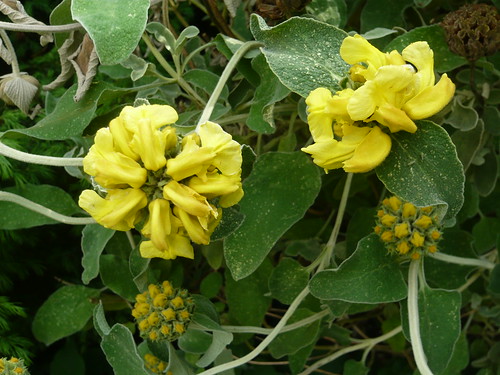Growing Phlomis Varieties

Phlomis are small shrubs for a warm sunny border. The unusual flower stems and Mediterranean style silver leaves make this a feature plant. They often grow 3-4′ high but there are many varieties that may differ in height.
Varieties of Phlomis
- Phlomis ‘Edward Bowles’ above is one of the readily available shrubby varieties. The square stems and whorls of yellow flowers are quite striking. It probably originated from a seed from Phlomis russeliana.
- Jerusalem Sage or Phlomis fruticosa may be damaged by late frosts but wait until the end of May to trim off affected shoots. Trim annually to avoid a leggy base.
- Phlomis tuberosa flowers from May with pink too purple flowers in whorls.
- Other Phlomis that may survive our winters include, Phlomis samia, Phlomis orientalis, Phlomis longifolium and Phlomis italica,
- Phlomis tuberosa is a hardy perennial with long flowering rich, ruby red stems flanked in whorls of lipped, candypink flowers. Deep green foliage and serated edges gives the perfect contrast.
Growing Tips for Phlomis
- Excellent drought tolerant herbaceous or shrubby perennials.
- They often have felted or hairy grey leaves.
- All varieties have many flowers arranged in whorls up the stems
- Seedheads form pepper pots with 4 seeds from every flower.
- Grow from seed sown in February to June or September to October – germination may take upto 4 months.
- Phlomis can also be propagated easily by division.
- Grow from cuttings taken between June and August. Remove flower buds and trim below a node.
- Seedheads last through winter, providing bird food and interesting winter shapes
- Phlomis appreciate well-drained soil and sunny spot and are often found wild around the Mediterranean.
- Phlomis are quite hardy in the UK
Uses of Phlomis
- Phlomis Russeliana can make good ground cover
- Yellow Phlomis mix well with blue geraniums
- Phlomis tuberosa growns 4 feet tall as does the shrub like fructcosa.
- Phlomis chrysophylla has soft woody growth to make a good shrub. Prune out old wood by one third to make them bushy
I grew my Phlomis from seed collected from a public garden in Shrewsbury but you can buy yours from Thompson Morgan
The book ‘Phlomis: The Neglected Genus’ by J M Taylor was reviewd by Tim Longville in The Hardy Plant-Vol.21, No.1 Spring 1999
‘”Jim Mann Taylor is one of the most ‘professional’ of these self-created ‘experts in a genus’, since he is a trained taxonomist and also runs a well-known and respected nursery, Just Phlomis, devoted to his passion. It is no surprise that his contribution to the series is the largest (and most expensive) so far. It is arranged in a straightforward and sensible way, with initial brief chapters on classification, distribution, propagation, cultivation and related matters, followed by a comprehensive account of all of the species presently in cultivation, either in private or botanic gardens. ‘ amazon review.
Top Gardening Links
The Royal Horticultural Society (RHS)
Alpine Garden Society (AGS)
BBC Gardening
Other pictures from Phlomis flower gallery

